Future Vision – Guantiva La Rusia
This is the vision of shared sustainable futures for the Páramo of Guantiva La Rusia that we designed as part of the Future Building Workshop, which took place in Duitama, Boyacá (Colombia) the 1st and 2nd December 2021 in the context of the project POR EL Páramo.
Click on a character or area to see their story!

The Tunjo

"In this space we wanted to represent the history of our Native Americans, the Chibchas and the Guanes, as this was a region shared between both that they deemed sacred, as part of their origins. Here we have the golden Tunjo in the enchanted lake. From there we started off as the origin of our lives, so we are part of the Páramo and the Páramo is part of us, thus with it we cohabit.” - Participants, Workshop at Duitama 2nd December 2021
Pathways

“The upper part is for conservation only, respecting the ancestral pathways – the ancient trail that communicated the Eastern plains with Santander and the Caribbean – where native American walked on. In it, we have a part where the community can use and enjoy those pathways without disturbing the ecosystem. In paper, what we have is a line of people, all walking inside the pathway, people in many colours. There is a person who is guiding and teaching from a place of love, from a position of feeling and appreciating the place.” - Participants, Workshop at Duitama 2nd December 2021
Páramo
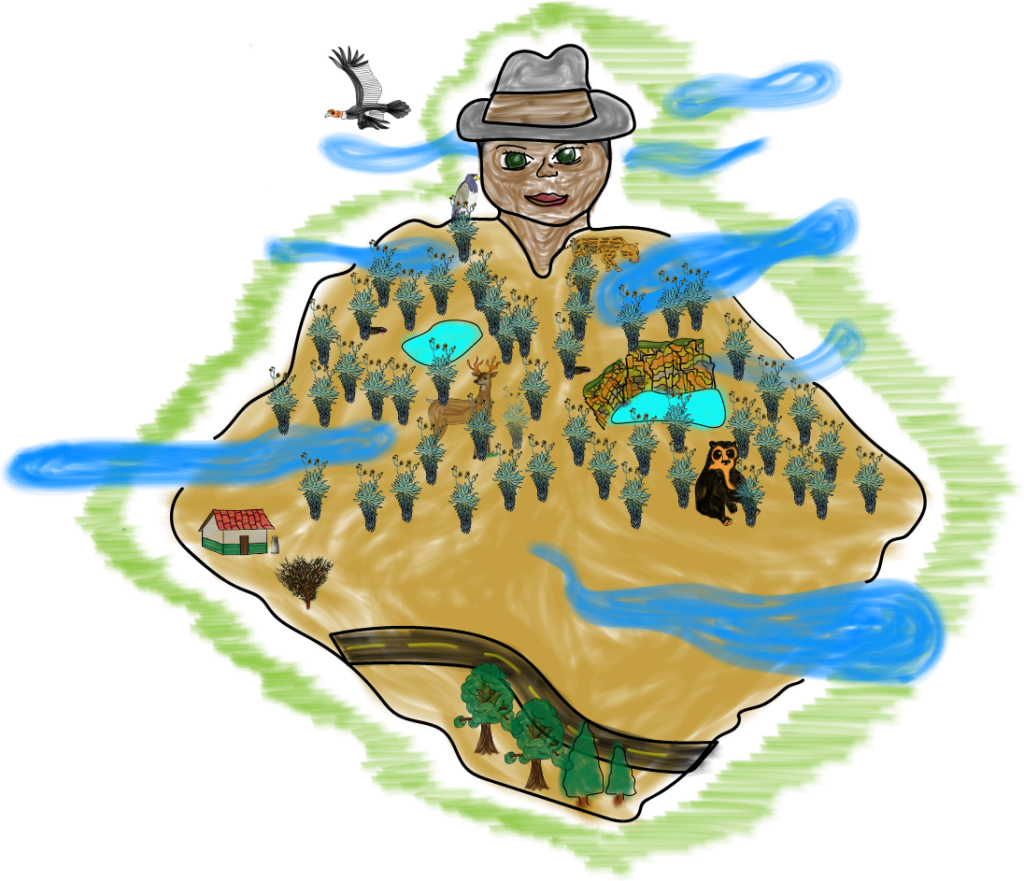
The Páramo is an eco- and sociosystem at the top of the Andes which captures the thin layer of water in the mist and brings it to the ground, thus producing water for towns and cities at high altitude. Life in it is delicate, but not for this it is less abundant, with a wide variety of species florishing in its hillsides. Like its neighbour Cloud Forest, its soil is fertile, but its cultivation can harm local species and weaken the ecosystem. Simlarly, extensive burning for crops can affect it beyond the point of recovery. The presence of minerals in it, and sometimes the building of roads, often brings problems to its survival.
Purposes and Hopes:
- To maintain the delicate balance of life at high altitude, with little oxygen and cold temperatures.
- To collect water for its soil, its species and its water streams.
- Bring back the plants and animals it has lost.
Fears and Frustrations:
- The expansion of large-scale economic activities impact its survival
- Its legal delimitation is often generalising or confusing.
- Wild fires and pollution
Goes along with: Paramunos, Conservationists, Local Species.
Sometimes does not go along with: Cows, Campesinos (if land use is extensive), Civil Servant and Institution (when they bring large projects).
Oak wildlife corridor

“In the centre of our banner is the oak wildlife corridor of Guantiva-La Rusia. There is a spot where it is interrupted because you have more (non-native) pines and eucalyptuses, but you see the exuberance in the native oak forests with two species that are quite representative for us because the dye in maroon the river waters, and we see a vast hydrological riches.” - Participants, Workshop at Duitama 2nd December 2021
Fauna and Flora
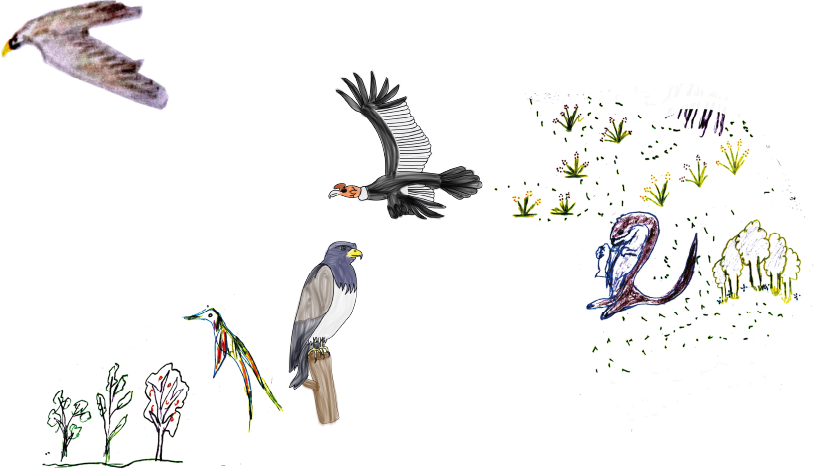
“Here we saw it in a way as a dream, as we drew the condors and the otters and some little animals that we hope to see in abundance in the Páramo again because they really have kind of disappeared. And of course the frailejones (Espeletias) as part of holistic sustainability. As long as the Páramo is healthy, we will be able to defend our subsistence.” - Participants, Workshop at Duitama 2nd December 2021
The Forest of the Colorados
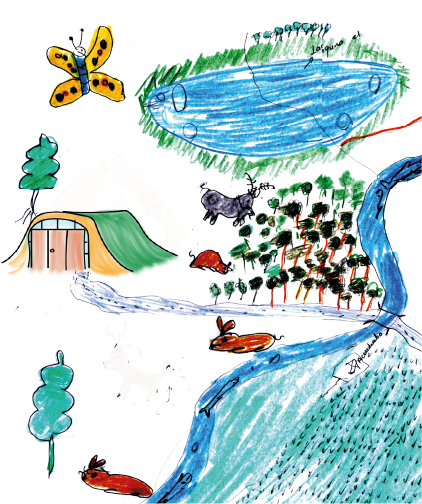
“Here we have the forest of the Colorados, which is the greatest richness we have in the (homonym) broad valley. We also find the Cazadero for which it does not matter that its waters flow towards Santander, for us is really important for its size. We think that perhaps in the future it will be possible to work with a ecotourism lodge house. We did not draw it too close to the lake, why? To prevent overflow. It is a project in the future, that perhaps two or three families could live out of a project like that.” - Participants, Workshop at Duitama 2nd December 2021
The Campesino and the Cyclist

“We also placed the campesino with his cow and with his crop. I decided to also draw a cyclist there waving at him and the campesino waving back with his hands out of the ruana (poncho), because sometimes people say “you never know what the campesino is saying under his poncho” but this one is with his arms wide open and greeting the cyclist who is going uphill, because many cyclists go there. So, we wanted to create this mixture of elements which is what creates an ecosystem.” - Participants, Workshop at Duitama 2nd December 2021
Campesinas and campesinos

Doña Úrsula and don Plinio have always worked on, and lived out of, the land, although only a few years back they went up to the Paramo looking for arable land. Work with crops and animals is their bread and butter, hence they are proud of being campesinos. They know the cycles of nature very well, thus adapting easily to different types of crop depending on what is more viable. Don Plinio is from the region and learnt all he knows from his parents and from some short courses he has taken. Doña Úrsula is not from the region, but she is well versed in agriculture engineering and knows how to manage technified crops if needed. Tomasito likes living here, but changing school these many times has made difficult to make friends, and more so now that he has to walk 1 hour to get to his school.
Purposes and Hopes:
- To cultivate and make their practice sustainable over time to seize economic and social security.
- To find efficient and manageable ways to live their lives out of the land.
- Redignify their labour through considering both what they learnt from their parents as well as new ideas about sustainability.
Fears and Frustrations:
- There are not enough guarantees for their work, and many times they had to change of economic activities to survive.
- Not being able to adapt.
- Policies often do not take them into account and even affect them negatively, particularly regarding the delimitation of the Paramo.
They go along with: Cows, Crops, Paramunos
Sometimes they do not go along with: Conservationists, Civil Servant and Institution when they design policies without consulting
Paramunas and paramunos
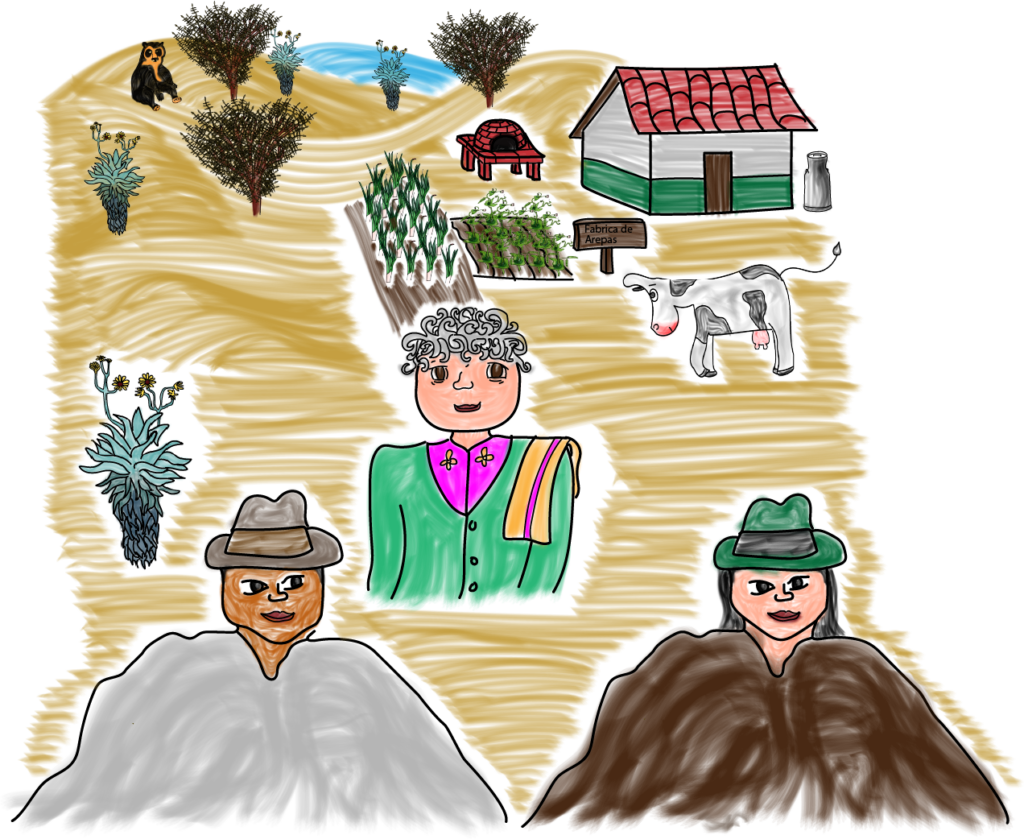
Doña Marina, don Eustasio y doña Clelia have lived all of their lives in the Páramo, hence they like being called Paramunos. They know each nook and cranny of their land like the back of their hands, and know every detail of how to work and look after the Paramo. While in there, they have worked with small-holding agriculture in different crops (potato, peas, onions), but recently it was proposed to Don Eustasio to look after and milk a cow, which he accepted as milk is what has a better market at the moment in his opinion. They also have a small substinence crop and share most of the labours there. Doña Clelia’s arepas are also very popular in the region.
Purposes and Hopes:
- To live in the Paramo. Regardless of the activity, the region is what identiies them.
- To make their lifestyle sustainable and their territory manageable.
Fears and Frustrations:
- There is no clarity on the delimitation and what can and cannot be done in the Páramo.
- Sudden changes lead to constant adaptations - desired or not - to different activities.
Goes along with: Páramo, Cloud Forest, Cows, Crops.
Sometimes doesn’t go along with: Some campesinos, specially when they are outsiders. Civil Servant and Institution (when they bring non-negotiated prohibitions)
Crops
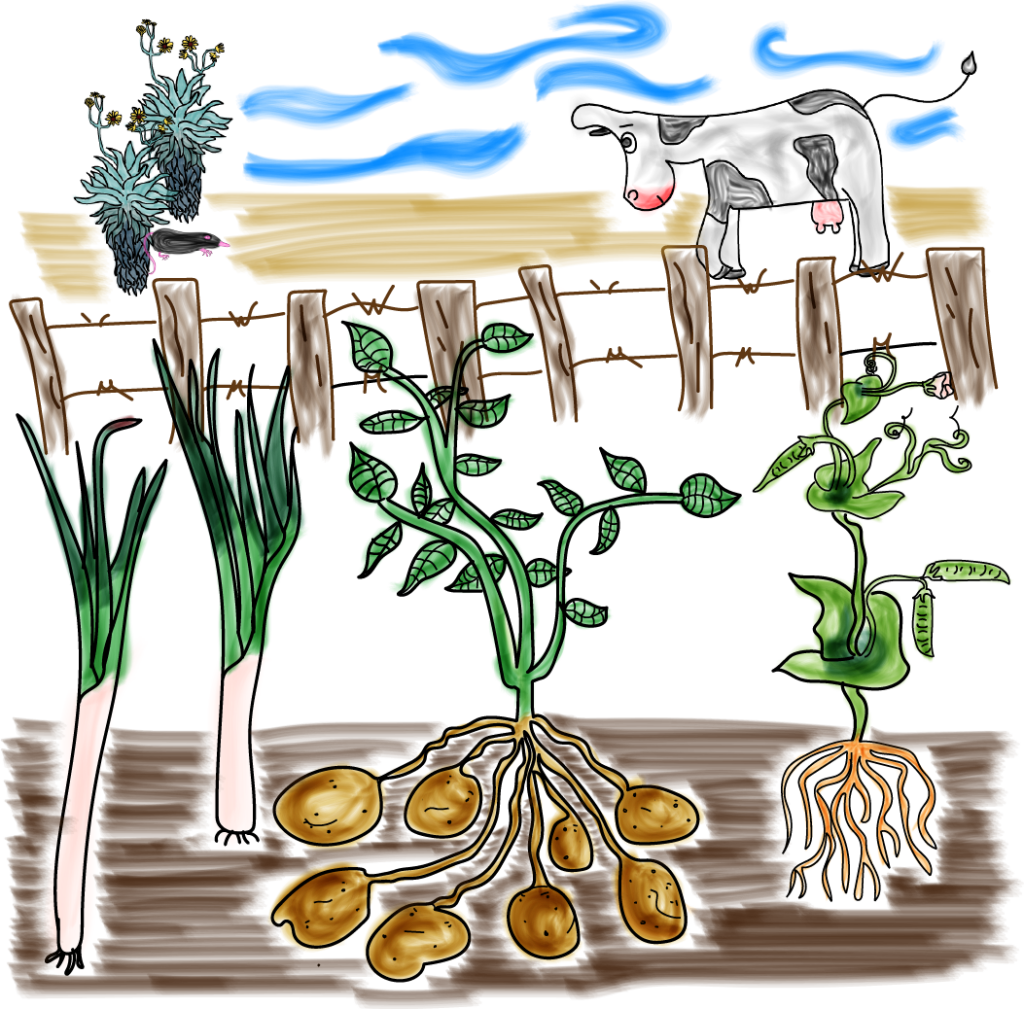
Onion, Potato, and Peas are a popular trio in the Páramo weather, although there are of course many other crops that also do well in the cold. They have supported campesinos for a long time and historically have provided sustenance. However, the need to burn in order to sow concerns some people and institutions.
Similarly, they require parceling up and fencing, which often clashes with the Páramo, which is believed to be affecting the ecosystem. Nonetheless, some believe they could be compatible.
Some crops have became noticeably less profitable in recent years, thus making many campesinos to abandon them and replace them with cows.
Purposes and hopes:
- To grow in fertile land.
- To facilitate the sustenance of those who live out of the land.
- Foster the establishment of supply and exchange networks.
Fears and Frustrations:
- The space they require affects the Paramo
- They have became outstandingly less profitable recently
Goes along with: Campesinos, Paramunos.
Sometimes doesn’t go along with: Native Species, The Páramo, The Cloud Forest, Conservationists, Cows in ocassions.
La Filemona
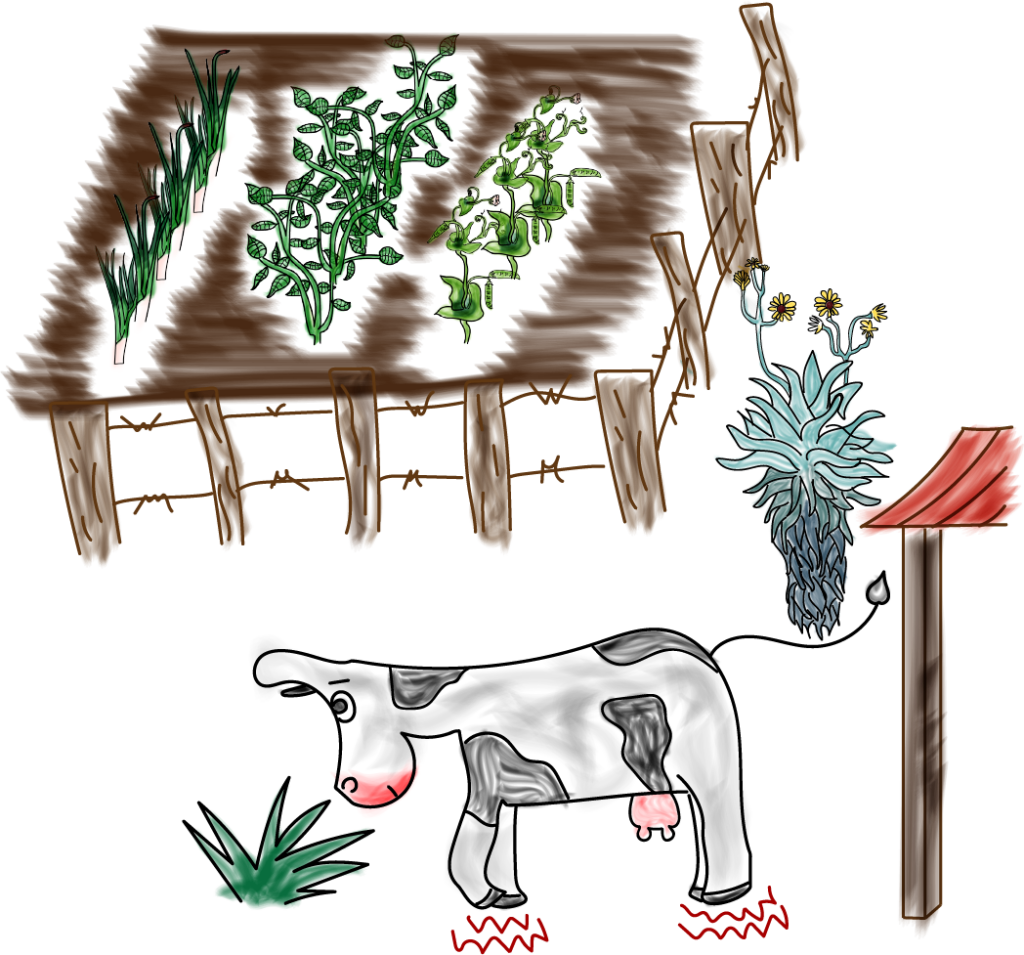
Filemona is a Holstein cow that produces milk for doña Úrsula, who bought her, and don Eustasio, who milks her. Both of them sell the milk jointly to a cheese factory. Recently, Filemona had to adapt to cold weather because the lack of land in the lowlands made Úrsula take her to don Eustasio at the Páramo. She likes the grass in there, but she has heard that her bites and hoofsteps may be affecting the ecosystem. Nevertheless, she is happy that thanks to her, both her owners share and socialise with the owners of other cows.
Purposes and hopes:
- To graze and stay active to produce milk for her owners, who in exchange look after her and provide her with enough space.
- To facilitate the economic and social inclusion of different members of the commmunity and favour supply autonomy.
Fears and Frustrations:
- There are rumours that her presence has an impact on the Paramo.
- These potential impacts and other socio-economic pressures often make her life precarious and cause her to change places often.
Goes along with: Campesinos, paramunos,
Sometimes doesn’t go along with: Native species, the Páramo, the Cloud Forest, Conservationists (specially when many of her friends are together in the same place).
Civil Servant and Institution
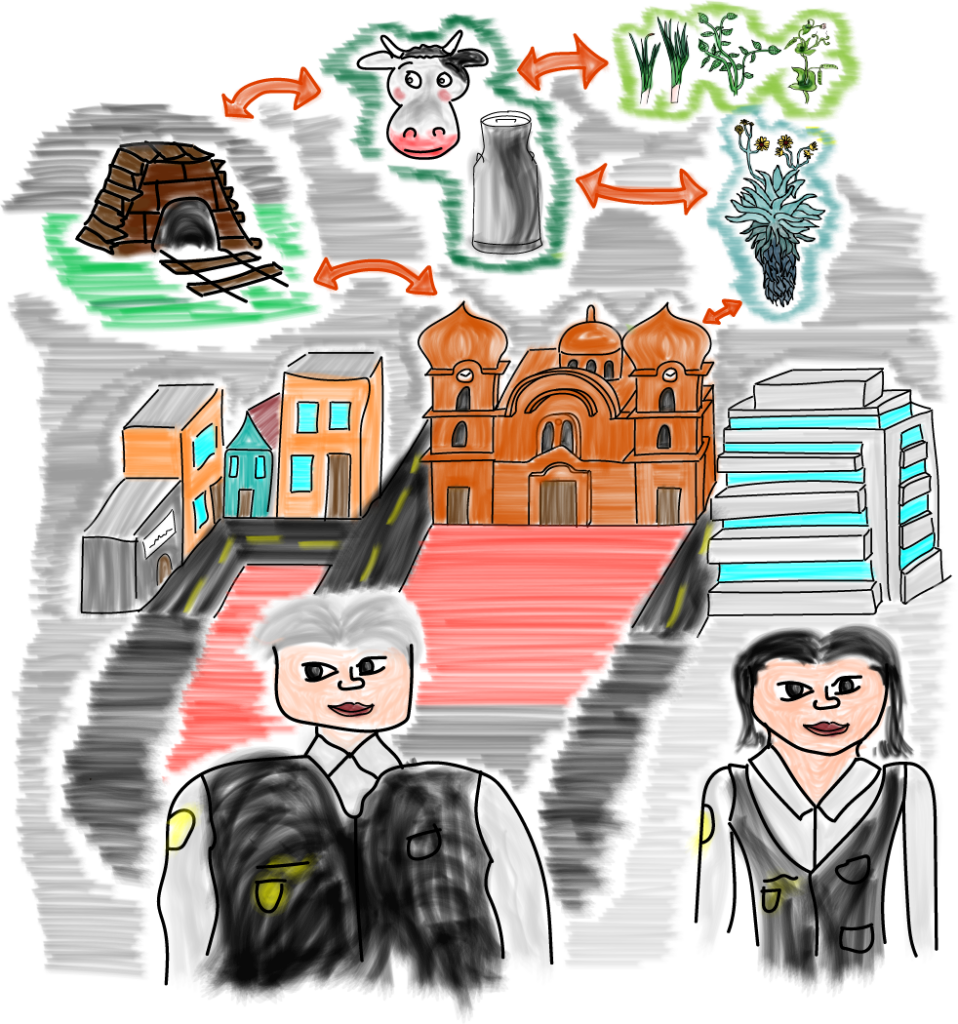
Civil Servant and Institution are whom often have the most decision-making capablities to defnie what can and cannot be done in the Páramo as they are the main contacts for consultation when the government has to create legislation. They must safeguard the Páramo, but also ensure that its inhabitants can live well and that different economic activities are compatible and sustainable. Similarly, they must reach agreements with local communities. Unfortunately, the inhabitants of the Páramo - Campesinos, Paramunos or Conservationists - do not feel they are being listened to. Civil Servant and Institution rarely belong to the Paramo and are generally sent from outside.
Purposes and Hopes:
- To inform decision-making by the government and report on local conditions.
- To generate agreement between different points of view, actors, and to reconcile tensions in the region.
- To follow-up and provide support to the different perspectives, social agents, and situations that exist in the Páramo.
Fears and Frustrations:
- It is often unclear how much attention they pay to local actors
- The large number of interests and activities involved in the Páramo makes it difficult to take decisions.
Goes along with: Conservationists, the government.
Sometimes doesn't go along with: Campesinos and Paramunos (when they do not feel listened to) the Páramo and the Cloud Forest when policies favour extractive acitivties.
Conservationists
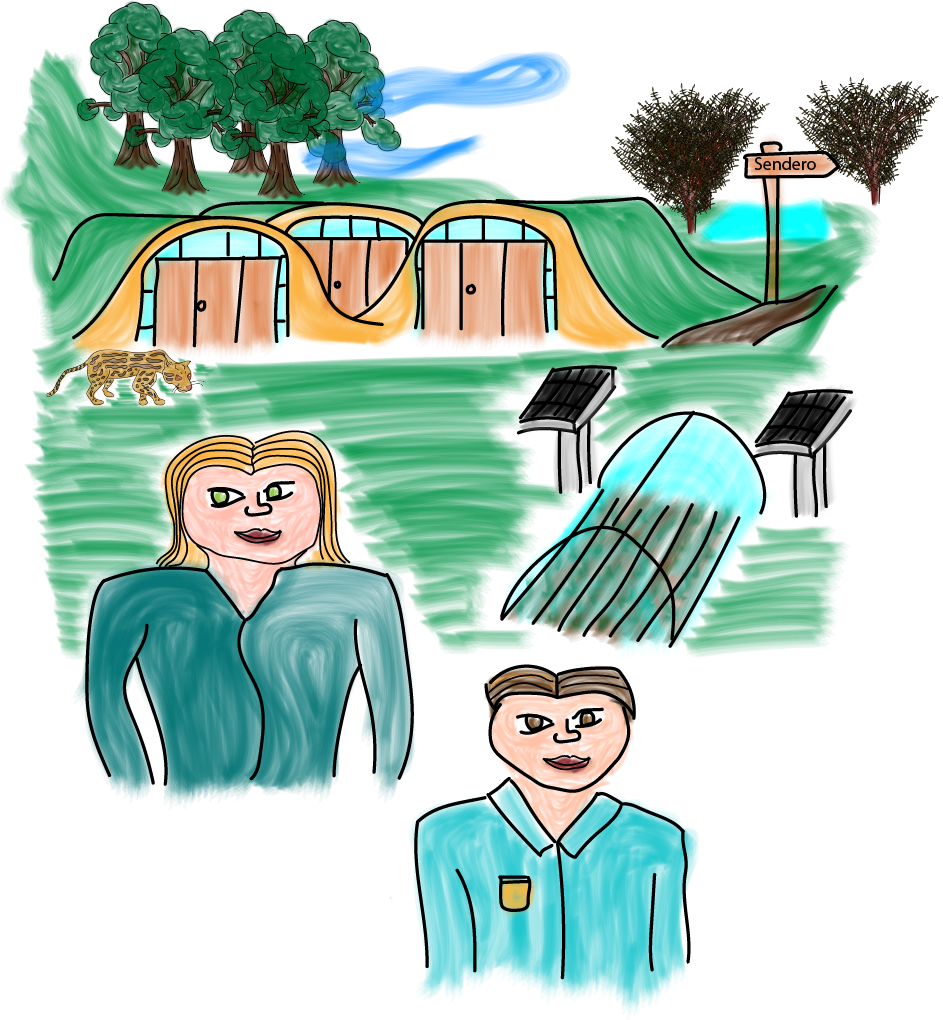
Mariana and Fernando love the Páramo, even though they were not born there. They consider it a very important ecosystem that must be protected for the enjoyment of local people as much as visitors, tourists and travellers. Hence, they have adapted a large portion of their property - which even has a lake - exclusively for eco-tourism and they are building eco-cabins to lodge visitors. They know about sustainable agriculture, but their main interest is ecosystem conservation. They are often concerned about certain practices like intensive grazing or the use of chemical fertilisers.
Purposes and Hopes:
- To generate sustainable practices that contribute to the conservation of the Páramo and to encourage dialogue about them.
- To live out of ecotourism as the practice they consider most sustainable and compatible with the ecosystem.
Fears and Frustrations:
- Their conservation services are not yet officially recognised or subsidised, which can put them at risk.
- Some common practices in the region seem to threaten the conservation of the Páramo.
Goes along with: The Páramo, The Cloud Forest, Other Conservationists.
Sometimes doesn’t go along with: Cows, Extensive Crops, some Campesinos with non-sustainable practices.
Andean Cloud Forest
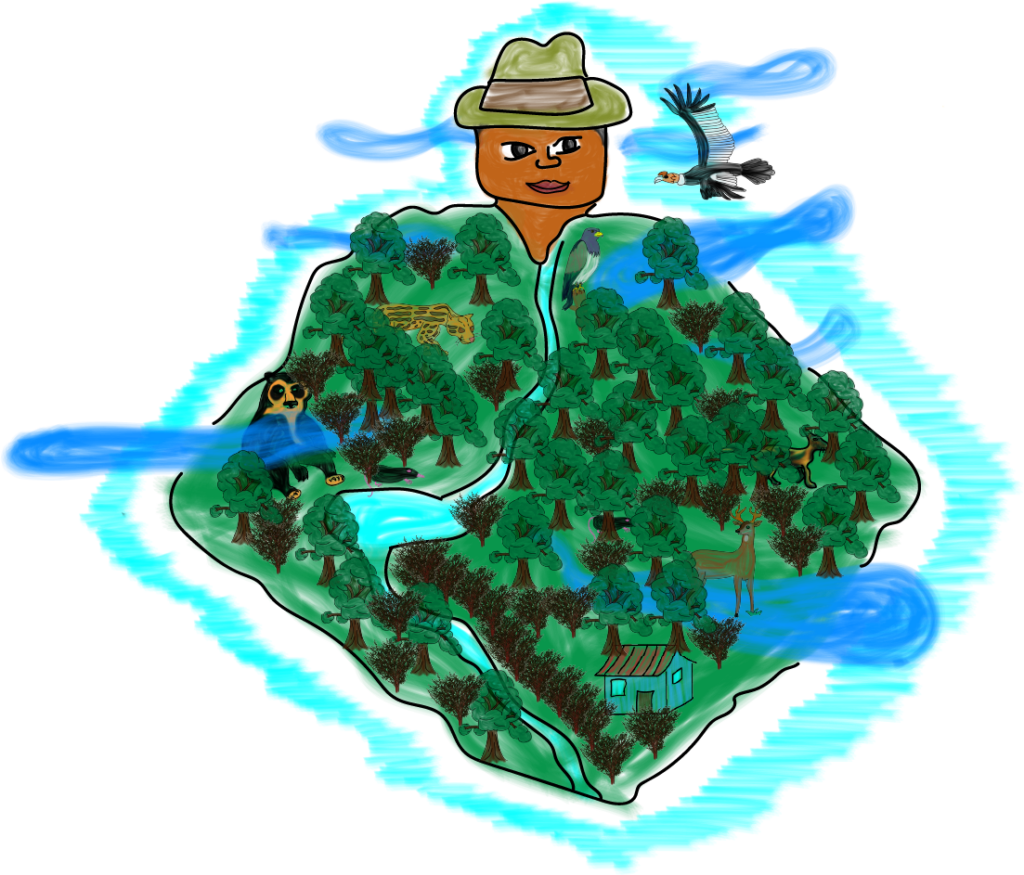
The Cloud Forest is an ecosystem high up in the Andes, although often the Páramo is above it. It has a dense vegetation with high oak and encenillo (Weinmannia tomentosa) forests, as well as some non-native species such as eucaliptus and pine some times. Life in it is abundant, and it is particularly popular amongst big wild mammals. Like in the Páramo, the soil is fertile, but often felling and planting crops, particularly wood production, as mineral extraction, can destroy it rapidily. It is one of the most popular areas for ecotourism.
Purpose and Hopes:
- To maintain and foster life in the high Andes, lodging a wide range of species.
- To conserve water sources, fertile soils and clean air for the benefit of those who inhabit and enjoy it.
Fears and Frustrations:
- The growth of extractive or large-scale activities threaten its survival.
- Its legal delimitation is limited and scattered, as the Paramos is often favoured in that sense.
- Irresponsible tourism.
Goes along with: Paramunos, Conservationists, Local Species.
Sometimes doesn’t go along with: Non-Native Species, Cows, Campesinos (when farming is extensive), Extractivist Policies.
Researchers
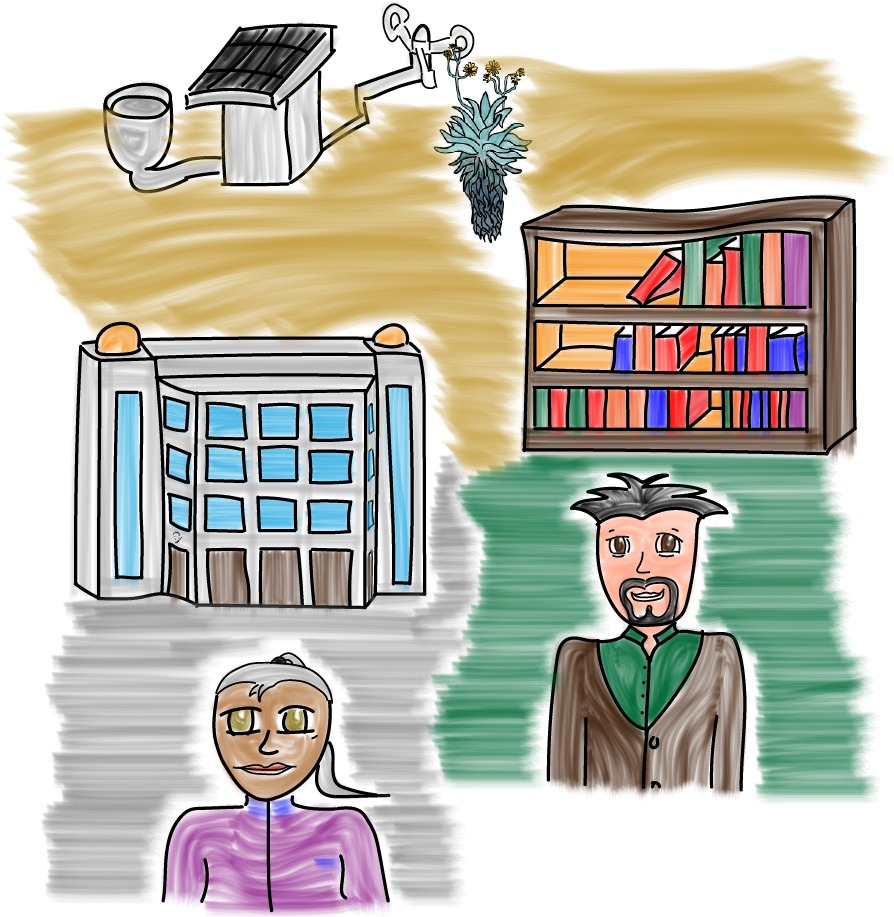
Ana is professor of biology at a university in Tunja and Jonathan is a researcher in social sciences at a university abroad. They work together on a project about the Páramo, which aims to collectively build alternatives for the Páramo to be sustainable, not only as an ecosystem, but also for those who have lived in there for a long time. Although they have worked in, and know, the area well, they are aware that the only way to generate truly useful knowledge is by listening to local inhabitants and experts, and by building that knowledge with them. In that sense, they enjoy facilitating the creation of that knowledge as well as contributing from their experience as academics. One of their biggest goals is that this production does not remain on bookshelves, but that is actively used by all those who can benefit from it.
Purposes and hopes:
- To generate useful and valuable knowledge about the conditions, phenomena, and cultural and social life in the Páramo.
- To facilitate the participation of different social agents so everyone’s knowledge is shared, created and recreated.
Fears and Frustrations:
- Sometimes knowledge is not correctly transmitted and what they do stays on bookshelves
- The application of their findings can be difficult and can be hindered by institutions or policies.
Goes along with: The Páramo, The Andean Cloud Forest, campesinos, conservationists and paramunos when researchers actively listen to them.
Sometimes doesn’t go along with: Civil servant and Institution when policies hinder good ideas, mining companies when they do not listen to evidence.